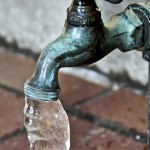The recent cold snap in our region was a sudden and brutal reminder that winter has arrived. You can and should prepare your house for cold temperatures to avoid higher than necessary heating costs and the potential headache of cleaning up and repairing after a burst pipe. The spate of public warnings about water main breaks around the City and posts on neighborhood listservs from frantic neighbors illustrates no one is immune from freezing pipes. As we hunker down and prepare for a few more months of winter, here are some tips to help you and your house survive.
1. Run ceiling fans in reverse. Many fans have a “winter” option that changes the rotation of the blades to clockwise. This will force warm air down (run fans counterclockwise in the summer to create a cool breeze). This will help keep you warmer and should have a positive affect on your heating bills.
2. Insulate drafty windows and doors with weather-stripping, caulk, insulating film or plastic, and door stops (even rolled towels work to minimize drafts).
3. Make sure your gutters and downspouts are clean so any melting snow can easily drain from the roof.
4. Winterize hose spigots or any other outside faucets. Remove the hose (if any), turn off water to the line from the inside, then open outside valve to drain the line. This will prevent any water in the line from freezing and possibly bursting the pipe when temperatures drop.
5. Be especially mindful of interior pipes that are susceptible to freezing-for example water supply pipes in unheated spaces like basements, crawlspaces, attics, and garages. Kitchen sink piping that is on an exterior wall can also be vulnerable. Insulate vulnerable pipes to the best of your ability. Leave kitchen sink cabinet doors open to increase the circulation of warm air.
6. If you are unable to insulate vulnerable pipes, leave the end fixture on those lines open on a slow drip. Pipes burst in cold weather for two reasons: first, water expands when it freezes and, if it expands enough, it can burst a pipe. But, secondly and most common, when water freezes in a pipe it creates an ice blockages. The pressure between the ice blockage and the faucet can build to excess and burst the pipe. Letting a faucet drip during extreme cold weather can prevent a pipe from bursting by preventing freezing to occur in the first place and also, by providing relief from the excessive pressure that can build between the faucet and the ice blockage.
7. Leave the heat on even when away from the house. Do not let the interior temperature of your house drop below 55° F.
8. If you suspect a pipe is frozen (usually the telltale sign is when you turn on the faucet and no water or only a trickle of water comes out), keep the faucet open while you are home and can monitor it (never leave the house with an open faucet). Running water through the pipe will help the ice melt. If you can reach the part of the pipe where you suspect it has frozen, you can accelerate thawing by applying an electric heating pad, hair dryer, hot towel or other heating method. Do not use an open flame. If you cannot reach the frozen area and the pipe does not thaw on its own, call a licensed plumber. If you have one frozen pipe, it’s prudent to check all of your fixtures to make sure they’re aren’t more.
Spring, come quickly! We’re patiently waiting.







